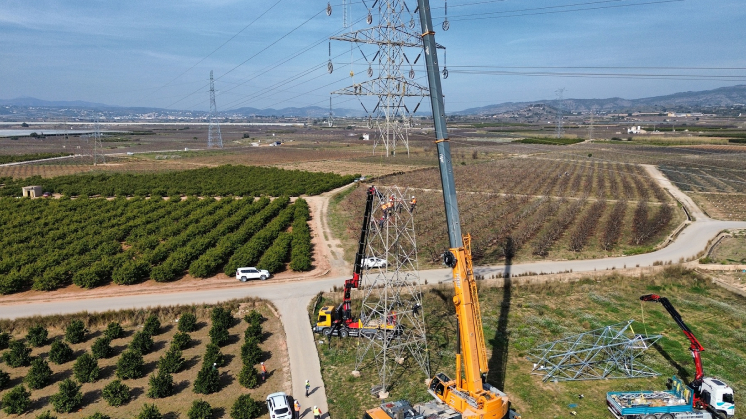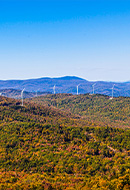Adapting to climate change
How to incorporate climate change adaptation – an urgent and necessary challenge for the coming decades
Electrical network Climate action Renewable energy
Extreme heatwaves, wildfires, drought and desertification are just some of the effects of global warming that we are already experiencing, and they are set to become more frequent and intense in the years ahead. Faced with this scenario, it is essential that we confront climate change not only through mitigation, but also by taking the necessary steps to adapt our surroundings to this new reality and minimise its negative impacts.

The recent climate events we have witnessed on our planet have made it clear that, alongside accelerating emission reductions, adaptation to climate change is more urgent than ever. Extreme weather phenomena such as the DANA in Spain or Hurricane Helena in the United States, which both occurred in 2024, are just some of the latest disasters showing that the consequences of climate change are a present threat. Science warns that climate change may intensify and make these events more frequent.
All of this is happening in a context where the rise in global temperature continues to break records. The latest data released by the Copernicus Climate Change Service (CS3) confirm this new reality: the period 2015-2024 was the warmest decade ever recorded. The same study also states that 2024 was the first year in which the average temperature increase exceeded 1.5°C compared with pre-industrial levels, a threshold that should not be surpassed by the end of the century to avoid the worst effects of climate change. What’s more, the increase in the concentration of greenhouse gases (GHG) in the atmosphere has impacts on other elements such as rising sea levels, ocean acidification, marine heatwaves and the reduction of the cryosphere, among others.
In this context, it is essential not only to address climate change mitigation but also to adopt measures that allow us to better withstand and minimise the effects of these impacts, as well as to protect the most vulnerable communities and groups, since these phenomena are expected to become increasingly frequent.
¿What is climate change adaptation?
It is true that efforts are being made in different parts of the world to curb global warming, although this trend will persist due to the inertia of our planet’s climate system. Precisely for this reason, it is essential to accelerate what is known as climate change adaptation. But what exactly does this concept mean?
According to the United Nations definition, climate change adaptation can be understood as the process of “adjusting ecological, social or economic systems in response to actual or expected climatic stimuli and their effects or impacts”. In other words, these are the measures that countries, communities and stakeholders in general need to implement to increase the resilience of their structures to the effects of climate change, with the aim of reducing, avoiding or withstanding the potential impacts that this process may cause.
These measures can be applied to various sectors, such as infrastructure, urban planning, agriculture or biodiversity, and require an ongoing process involving cooperation between governments, the private sector, civil society and local communities. Examples of adaptation include:

Climate action plan
Iberdrola is leading the way towards a decarbonised economy.

Committed to the SDGs
Our commitment to the Sustainable Development Goals.

SDG 13: Climate action
We actively and firmly contribute to a sustainable, low-carbon future.

Economic impacts of climate change
Climate change is a serious threat to the global economy.

Trees Programme
Iberdrola’s programme aims to plant 20 million trees by 2030.
Climate change adaptation in the energy sector
In recent years, adaptation strategies have gained greater prominence on the climate agenda, especially after the signing of the Paris Agreement in 2015 – whose Article 7 defines it as “a global challenge faced by all with local, subnational, national, regional and international dimensions”. One of the sectors that has made the most progress in incorporating adaptation plans is the energy sector.
According to a study by S&P Global, the highest proportion of companies with adaptation plans is found precisely in the utility (40%) and energy (30%) sectors. Furthermore, within the utility sector, electricity companies are those most likely to adopt measures to adapt to the new reality (62%), followed by water retailers (23%) and gas companies (15%).
This simply reflects the importance of the energy sector in helping the planet adapt to climate change. Indeed, the roadmap for the energy transition towards a decarbonised, safer, more efficient, more competitive and more resilient model also means that all infrastructures must be prepared for the future context. For this reason, every company in the sector must have assets and systems capable of withstanding variations in climatic conditions – in other words, climate-resilient infrastructure that is designed, built and operated to anticipate, prepare for and adapt to changing climate conditions.
Adapting to climate change in the energy sector
Climate change is having an increasing effect on the energy sector. Adapting to these changes is essential to ensure the continuity and security of energy supply. The following information outlines how climate change is impacting energy infrastructures and how companies can manage these effects.
Click on the buttons to expand the information
 SEE INFOGRAPHIC: Adapting to climate change in the energy sector [PDF]
SEE INFOGRAPHIC: Adapting to climate change in the energy sector [PDF]
The role of businesses
The private sector plays a crucial role in adapting to the climate emergency. Harnessing the vast potential of business is one of the keys to addressing the impacts of global warming. In this regard, companies have a wide scope for action – from developing internal policies based on operational and sustainability objectives to collaborating with third parties.
Among the various strategies and approaches that businesses can adopt are natural capital policies, which address environmental and climate challenges as well as biodiversity loss. These policies help organisations build the resilience needed to cope with the impacts of climate change.
At Iberdrola, we have an updated Climate Action Policy that includes adaptation as one of its core pillars. Its key lines of action include analysing climate-related risks and opportunities within the context of the energy transition, assessing physical risks, and integrating climate science alongside adaptation and resilience criteria to reduce or prevent the potential impacts of climate change on our activities.
Iberdrola’s commitment to adapting to climate change
For more than 20 years, Iberdrola has been firmly committed to the energy transition and recognises the contribution of its activities to climate action. On one hand, through mitigation, by reducing emissions and investing in renewables, storage and smart grids. On the other, by simultaneously integrating climate change adaptation and resilience into its processes and operations. These two approaches come together as essential elements in the move towards a decarbonised, sustainable and resilient energy model.
Iberdrola’s commitment to operational excellence and quality of supply also means that, in the face of climate impacts, the company analyses and implements the necessary measures to maintain its standards. Iberdrola has several initiatives designed for enhancing the resilience of its facilities against the potential effects of climate change and is working under a framework of continuous improvement. Guided by the latest climate science, the company seeks to further strengthen the integration of climate considerations into its operations. Here are a few examples:
Predictive anticipation systems
- Meteoflow: this tool is primarily designed to forecast the electricity production of renewable facilities across different countries. In recent years, however, Meteoflow has incorporated functionality for predicting extreme weather events. One of its most notable features is its ice-formation alert, which enables proactive action – mobilising personnel in advance, deploying backup generators and using drones and helicopters for inspection.
- Domina: this system enables regular monitoring of operational systems, allowing early detection of potential faults. Thanks to this tool, Iberdrola can anticipate problems, enhance its response capability and carry out repairs more efficiently and cost-effectively.
Digitalisation and automation
We are equipping our electricity transmission and distribution networks with smarter infrastructure – a technological leap that is key to strengthening the resilience of power lines. Increasing the level of automation in the medium-voltage network improves the speed of fault identification, isolation and restoration.
Design and operational measures
- Undergrounding of overhead lines: in areas exposed to extreme weather events or at higher risk due to their geographical conditions, we have undertaken the undergrounding of overhead networks to enhance the resilience of our infrastructure.
- Vegetation maintenance and pruning: improving vegetation management plans beneath overhead lines is a crucial measure to prevent damage caused by falling trees during adverse weather events.
- Emergency and early warning systems: we have incorporated the use of drones and LIDAR inspection systems, which employ laser technology for detailed facility assessments and more precise detection of potential damage.
- Facility design improvements: the company has introduced new materials capable of withstanding high temperatures and designed substations and transformer centres that can maintain service even under extreme conditions such as floods or fires. It has also adapted equipment to the specific conditions of each site, including the installation of turbines resistant to typhoons and strong winds.
Physical risk analysis
The company has developed a risk-analysis system based on Intergovernmental Panel on Climate Change (IPCC) climate scenarios to assess the potential impacts of climate change on all group facilities. This analysis is applied both globally and within project investment dossiers, ensuring that future initiatives align with best practices in climate change adaptation.

























